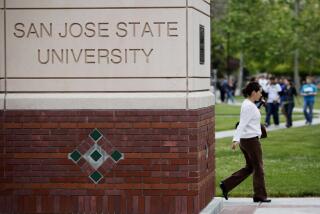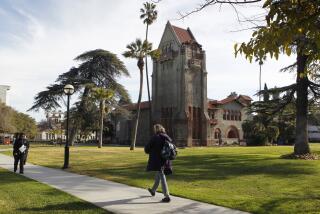Cal State San Marcos Endowment Questioned : Education: President accepts unusual conditions on geology study that could open new university to academic ridicule.
- Share via
Cal State San Marcos has agreed to conditions for a quarter-million-dollar geology endowment that academics believe could make the brand-new state university a laughingstock of the nation’s educational community.
The money comes from a lifelong Carlsbad farmer and cattle rancher whose self-studied theories on how the Earth’s surface was shaped are widely regarded as outlandish by geologists. Under the agreement, the university commits any professor who fills the position to study the donor’s disregarded theories and issue annual reports on the findings.
Professors and administrators at other universities say the agreement with Allan O. Kelly, the 89-year-old descendant of a Carlsbad pioneer, violates traditional procedures for establishing endowed chairs and canons regarding a professor’s freedom to research areas of his or her own interest. The endowed chair is unlikely to attract any legitimate scientist, they said.
In addition, the endowment agreement puts taxpayers in the position of footing the long-term, potentially multimillion-dollar, bill to study Kelly’s theories, because public dollars pay the annual salary and benefits of any professor hired in the Cal State system. The endowment only supplements a person’s ability to carry out research or lessen the teaching load.
“It’s a ridiculous way of appointing people, a dangerous way of appointing people, and I doubt any serious scientist would take an (endowed) chair under those conditions,” Miriam Kastner, chair of the geological research division at UC San Diego’s Scripps Institution of Oceanography, said Tuesday.
“It’s hard to turn down money, and I don’t want to get into an (argument) with San Marcos, but it’s unthinkable in the academic world to allow a donor to set the conditions either on who the person might be or what area specifically he or she will investigate--it’s just unthinkable,” said Albert W. Johnson, vice president of academic affairs at San Diego State University.
The agreement between Kelly and Cal State San Marcos President William Stacy was officially announced Thursday and is scheduled for signing this week, Stacy said Tuesday. Among its major conditions:
* The endowment would in part be used to study “the truth or falsity of Mr. Kelly’s theories.”
* An annual report or monograph focusing on the studies of Kelly’s theories must be produced and given to Kelly. “Each year, specific systematic, scientific and scholarly attention, including field study shall be focused in this area,” the agreement states.
* A professor will be formally appointed only after San Marcos assures Kelly or his representative that annual study of his theories is ready to begin.
* The chair would become the “premier professor” among about 20 professors in the 1991-92 academic year. Beyond having the name “premier,” it is unclear what this status would mean.
Stacy defended the agreement Tuesday, saying that “it allows the academic freedom of the institution and professor be guaranteed, but also gives to Mr. Kelly some reasonable assurance that the matters of special concern will receive scientific consideration.”
But Stacy conceded that the unusual arrangement could prove difficult to carry out.
“The professorship is not something that will be thrust upon somebody,” he said, “and, if it is something that a professor finds a great deal of discomfort with, it simply won’t be in existence.”
Kelly also defended his stipulations in a telephone interview Tuesday, saying, “I have a right to see that they (the university) go along with the idea” of studying his impact-gravitational theory.
In essence, Kelly believes that very large asteroids and meteors have struck Earth up until recent times, causing most of the Earth’s formations as well as triggering the end of the most recent Ice Age and the biblical flood of Noah’s time.
He believes an asteroid 300 miles in diameter struck the Carolina coast about 11,000 years ago at 20 miles per second, creating a crater 2,000 miles wide that changed the Earth’s tilt 30 degrees.
“I can’t see any reason why I should put in $250,000 for a theory that would be pushed under the rug,” Kelly said.
“The geologic community will not accept this because I am not a scientist, and I don’t have a degree,” said Kelly, who self-published a book in 1953 on the subject. “Scientists are no more honest than the bankers or anyone else.
“I don’t have any trouble convincing the ordinary citizen of the reality of impact theory . . . but all the big universities of the world . . . hate my guts because I’m the only one that has been giving them a hard time. I’m an old man, and I want this thing to go on, and I want a university to carry on the idea of impact geology.”
But geologists find Kelly’s theories ludicrous--although they would find nothing wrong with establishing a geology chair in the specialized area of impact geology--and they believe no one will accept a position with the existing conditions.
“In terms of the overall philosophy of having an endowed chair to study the effects of cosmic impacts on Earth, that would be a bold step,” Peter Schultz, professor of geology at Brown University and a specialist on impact theory, said Tuesday.
“But those types of objects that Kelly talks about, an asteroid 300 miles across, just don’t exist,” Schultz said. “In the last 500 million years, we’ve had 116 impacts on land, and the largest one was 100 kilometers (60 miles) in diameter.”
Schultz said the present shape of the Earth results from internal forces, not from impacts. “We have continents floating across, and we have plates that literally move across the surface of the Earth,” he said, “and those are all triggered by changing internal conditions, not by impacts.”
Other professors of geology contacted by The Times found the endowment agreement as hard to swallow as Kelly’s theories.
The agreement states that the money must “in specific part be used to conduct annually appropriate systematic, scientific study of the general area of the effect of space body impact and near misses with the Earth and potentially resulting cosmic effect upon the Earth, primarily during the Holocene period (approximately 10,000 years ago to present) and the truth or falsity of Mr. Kelly’s theories.”
UCSD geologist J. Douglas MacDougall said he “had never heard of such conditions (for an endowed chair). Nope, I wouldn’t take it, you sure don’t want those as an ongoing condition” of research.
Michael J. Walawender, chair of San Diego State University’s geology department, did his doctorate on impact theory and has known of Kelly’s theories for years.
“I’m just overwhelmed that this was accepted by the San Marcos campus,” Walawender said. “This is contrary to scientific methodology in having a specific mandate to go out and prove a theory.
“Impact theory is an intriguing thing, but Mr. Kelly sees things that nobody else does, he sees normal features in terrestrial rocks and interprets them as impact features, where the rest of the world sees them as normal.
“I can’t imagine anyone would want this chair unless you had a brand-new Ph.D who couldn’t find a job anywhere else.”
Education officials found the endowment agreement equally unacceptable.
The conditions might be “academically irresponsible” by requiring a professor to study a theory rejected “by the preponderance of the scientific community,” said Reginald Wilson, a senior scholar with the Washington-based American Council on Education. “Any institution that accepted it under those conditions certainly would not be acting responsibly.”
A California university administrator, who asked not to be named, said his faculty “would eat me alive” if his institution ever agreed to such stipulations.
“Stacy should have been able to talk him into much, much vaguer language,” the administrator said. Usually a donor wants to do something for the academic institution and has no interest in any personal gain other than having his or her name on the endowed chair, he added.
Pat Abbott, professor and former chair of geology at San Diego State, said, “I don’t understand how Stacy could sign this. I don’t know the man, but I think he made a serious error in judgment.”
But Stacy, who retains the final say on whether the agreement goes forward, said, “I don’t think it is improper to have some attention on a lifetime of (Kelly’s) work,” because the professor will only need to study, not to back up, Kelly’s theory. Also, the professor will be allowed to pursue other research in besides Kelly’s theories, Stacy said.
“I think it is an opportunity for enhancement of the university’s teaching mission and an appreciation of the man’s (Kelly’s) generosity to the university,” he said.
Stacy did say that his job “would be easier” if Kelly had not put conditions on the donation but had allowed an endowment to be phrased in general terms, as did Bill Daniels, a cable television pioneer, when he donated $250,000 last week for a chair in communications.
The Cal State system allows its campus presidents to forge endowment agreements without review by systemwide administrators or by the board of trustees. In contrast, the University of California Board of Regents retains the final approval of any proposed endowed chair, after the faculty and chancellor of the individual campus have signed off.
Stacy said his 10 founding faculty members, who act as an advisory group, will play an important role in determining whether the Kelly chair will eventually be filled. The faculty, which has not yet been informed about the conditions of the agreement, would have to authorize the search for the new professor.
“And, if we want this professorship, we will then see what (a search) that ordinarily would produce 50 to 100 applicants” will produce in this case, he said.
More to Read
Sign up for Essential California
The most important California stories and recommendations in your inbox every morning.
You may occasionally receive promotional content from the Los Angeles Times.













